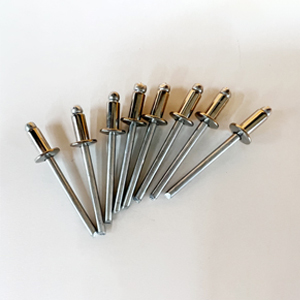In daily life, products such as blind rivets are often seen with gloss and strong corrosion resistance. Next, I will introduce how to solve the problems of blind rivets and common situations.
Generally, a layer of cadmium is embedded on the surface of the blind rivet, which can improve the corrosion resistance of the surface of the blind rivet. The waste water after cadmium plating is very expensive to solve, and it is not recommended to be used in the natural environment. The surface of the blind rivet after cadmium plating is exposed to the air. It is relatively stable, not easy to change color or dull, and has relatively high strength. But it is not uncommon in industrial production with high anti-corrosion regulations. When it is not tightened, the gap will be larger, which can be used for corrosion resistance and compressive strength of thick coatings. Some are not easily damaged.
Blind rivet burr is a common situation in blind rivets. Pull through: The rivet core is generally pulled out from the rivet body, the fracture surface of the rivet core is not broken, and there are peripheral cracks in the rivet body after riveting. Reason: The pulling force of the rivet core is too large , The diameter of the rivet core cap is too small, the material of the rivet body is too soft, and the thread surface of the rivet body is too wet.
Common cases of blind rivets
Insufficient jumping head or bulging: when the rivet is first pulled, the reason may be that the rivet core is all ejected, or the rivet body is not fully unfolded. Reason: due to the low stretching operation and high rivet strength in the manufacturing process of the mandrel, the mandrel is in the whole process. Hydrogen embrittlement occurs during electroplating.
The rivet head falls off: after riveting, it should be noted that the rivet head cannot be covered with glue and falls off from the rivet body. The reasons for the falling off are as follows: because the diameter of the mandrel cap is too large, the rivet body becomes shorter, resulting in a mismatch with the thickness of the rivet.
Blind rivet burr: After riveting, the burr of the broken hole of the rivet core passes through the hole of the rivet body or the thread in the rivet body to make the surrounding meridians protrude, resulting in burrs that scratch the hand. The reason for the burr: the diameter of the rivet core cap is too small , The material of the rivet body is soft, the punching diameter of the product workpiece is too large, the specification and model of the rivet gun nozzle is too large, the distance between the fracture surface of the rivet core and the rivet core head is too large, and the specific riveting thickness is exceeded.

Related Industry Knowledge
- Types and uses of rivets
- Use of rivet gun
- Application and characteristics of lantern rivets
- Rivet nuts and their installation and precautions
- Introduction of seahorse rivets
- The difference between ring groove rivets and groove rivets
- The use and precautions of ring groove rivets
- Development and working principle of blind rivets
- Uses and advantages of large brim blind rivets
- Characteristics of brushed rivets
- How to choose blind rivets, and what aspects must be paid attention to?
- The whole process of using and installing ring groove rivets
- What are the solutions when the riveting gun fails?



